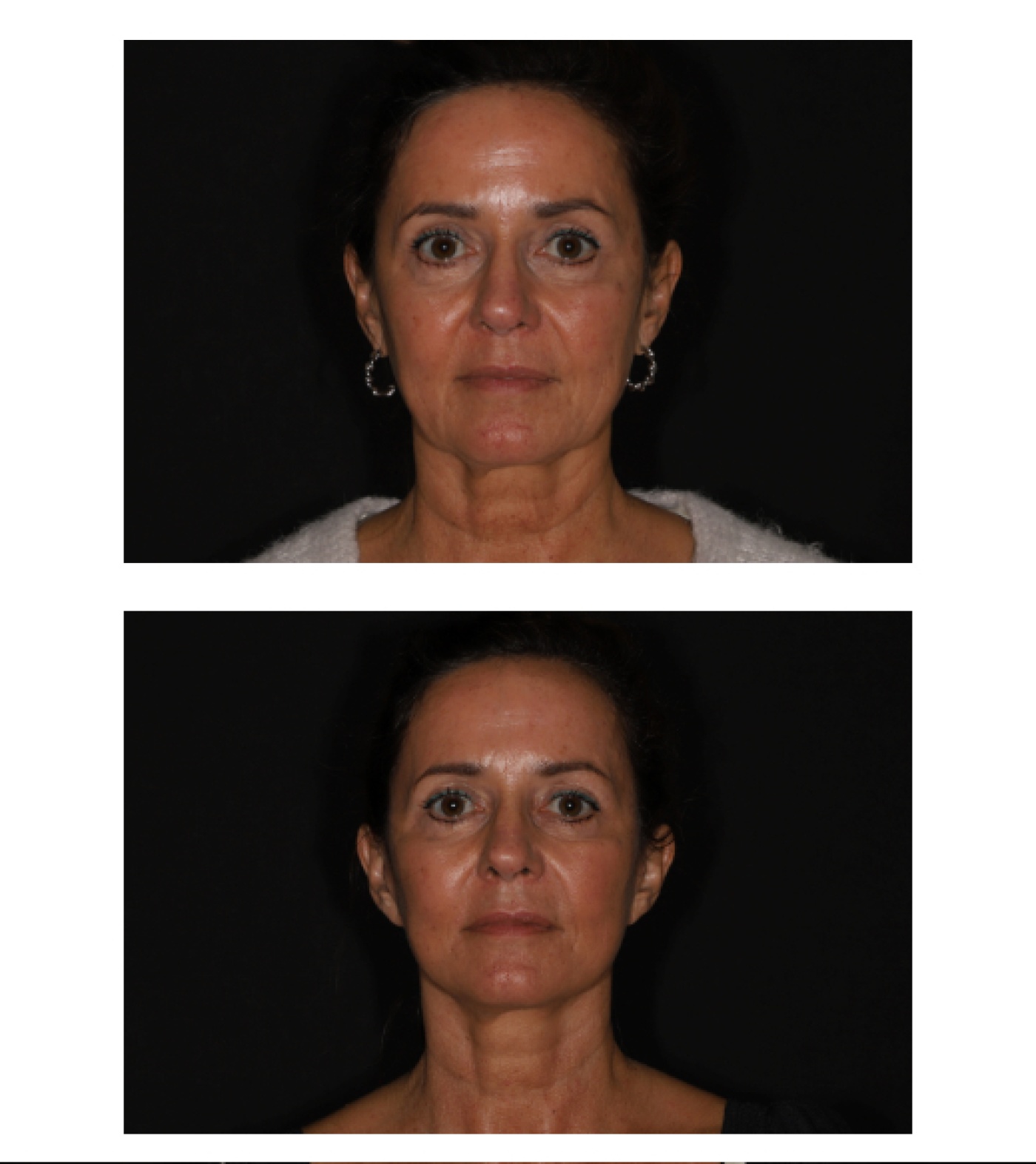Facelift and face-necklift
The facelift is the most renowned procedure in the field of plastic surgery. It is a well-known term, but the techniques may vary. The purpose of the facelift is to give someone a fresher, younger appearance. The various methods, names, and abbreviations may sound complicated, but they are essentially the same: the movement of volume and lifting of the deeper layers of the face. Skill and an eye for aesthetics are key to a good result.
1. What is a facelift?
As a result of ageing, the skin and underlying tissue layers start to sag towards the corner of the mouth, the jawline and neck. A facelift and/or neck lift reattaches these layers in their original position.▲
2. What types of facelifts are there?
A facelift focuses on the lower part of the face, from the cheekbones down to the neck. The upper part of the face is tackled with a brow lift, a forehead lift, and upper and lower eyelid corrections.
Facelift techniques differ in how the deeper tissue is repositioned. These tissues can be moved by folding them back, removing a strip of the SMAS layer and stitching the skin back in a better position, or moving the deep tissue as a whole. All methods have advantages and disadvantages. Facelifts that only tighten the skin (often called a "mini facelift") usually have a limited and short-term effect.
Lipofilling is an essential part of facial rejuvenation nowadays because ageing causes the thinning of the fatty layer in the face. In addition to adding volume, lipofilling also positively affects the quality and texture of the skin.
There are multiple treatment options for people looking for a facelift, so do not be surprised that different surgeons present and use varied methods. My technique restores volume and contour by lifting and building up the subcutaneous fat and tissue layers. I do this using the Enbloc technique combined with SMAS folding.
Midface lift
Due to ageing, the cheeks can start to droop and appear to "fall off' the cheekbones. While a facelift can add some volume to the cheeks, a midface lift focuses solely on this result. The skin and the fatty tissue are moved back towards the cheekbones. The midface lift can be considered an extension of the lower eyelid correction. However, the intervention is only suitable for a limited group of clients.
Neck lift
The neck lift is usually part of the facelift but can occasionally be performed as a stand-alone procedure. If the client has a voluminous neck, liposuction may be an option. A prerequisite for liposuction is the presence of disproportionate fat in the neck and sufficient elasticity of the skin so it can adapt to the new contour. In a pronounced 'turkey neck', surgical correction via a scar in the neck or under the chin can be an option. Liposuction and surgical correction can also be combined. As mentioned earlier, the surplus in the neck is always the result of ageing in the entire face, and the facelift is the central pillar of the treatment.
SMAS
The SMAS (superficial musculoaponeurotic system) is a layer of fat and fascia connected to the neck's platysma muscle. This method leads to a longer-lasting result, and lifting this layer has a positive effect on the neck. The extent to which the neck benefits depends on the extent of the procedure. For a greater effect on the neck, the facelift gradually changes into a face-neck lift. A scar under the chin allows additional work on the neck; the scar behind the ear can be extended into the hairline..
3. What is the cause of ageing in the face?
Sagging facial skin is caused by ageing: an altered hormone balance after menopause, sun damage, the reduction of subcutaneous fat and decreased skin elasticity. Combined with gravity, this leads to deeper folds around the corners of the mouth and a surplus under the jawline and neck. (Significant) weight loss can speed up this process.
4. When do When do you choose for a facelift?
When the above-described signs of ageing start to appear, you can decide to get a facelift. The procedure is recommended when there is a certain minimum of (ageing) symptoms. If you have a facelift early, the result will be subtle. On average, clients usually have their first facelift after 50. A facelift can be repeated several times, even in old age. I can advise you on this during the consultation.
5. The facelift treatment
The consultation
During this introductory meeting, I conduct an examination to compare the treatment request with my observations. I look with a trained eye, which may give you a surprisingly new perspective. For example, you come in for a facelift. However, I see sagging eyebrows or pronounced bags under your eyes, and I feel you would benefit more from a forehead lift or a lower eyelid correction. The correct diagnosis ultimately leads to the best treatment result.
During the first appointment, we will take stock of your medical history and any risk factors such as smoking, the use of anticoagulants, high blood pressure, etcetera. My consultant, who will be present at the meeting, will provide information on funding, scheduling, and logistics in the clinic.
The procedure
During the facelift procedure, the surgeon cuts in or behind the sideburns, then along the ear, around the earlobe and in the fold behind the ear, possibly extending further into the posterior hairline. The skin is partially detached in the direction of the corner of the mouth, along the jaw line and partially behind the ear.
The deeper layers are lifted and stitched, restoring them to their original position. The excess skin is removed and stitched without stretching the skin excessively. The procedure takes approximately two hours and takes place under sedation (monitored anaesthesia care via an IV), together with local anaesthesia of the entire surgical site. This means you are not fully awake during the procedure and not feeling pain. You can breathe unassisted, with some oxygen administered through a nose cannula, so you are not under general anaesthetic but supervised and monitored by the anaesthetist and the anaesthesia nurse.
A neck lift/platysmaplasty sometimes starts with liposuction. Next, an opening under the chin is used to detach the skin. The remaining excess fat is removed, and the platysma muscle is shortened. The skin is then put back, closed and fixed to the base layer with some stitches.
After the procedure
You will not feel pain after the facelift and/or neck lift. Even after the anaesthesia wears off, you will not have any pain; at most, it might feel a little tight.
In the recovery room, the temporary dressing is changed after 3-4 hours, and you will be fitted with a removable compression mask that you will wear at home at the end of the afternoon. The following day, you can take the mask off to shower and wash your hair, using your own shampoo. After that, you can shower daily and rinse the wounds (keeping the wounds clean is good for healing). You do not need to wash your hair every day. You will wear the mask for about 5 days or as long as it feels safe and comfortable. During your one-week check-up visit, some staples are removed (those in the ear fold may sometimes be slightly sensitive). After two weeks, the remaining staples are removed, and the knots of the soluble sutures are cut off. Until the scars are completely healed, I recommend not applying any cream to the scars, as this can cause irritation and inflammation.
After the neck lift/platysmaplasty, you also go home with the temporary bandage. You can remove this bandage the following day and start taking daily showers (you can also rinse off the wound). You will wear the compression mask until the first check-up. The stitches are removed after 5 and 10 days.
After the surgery, you may be worried about your recovery, and you could be extra sensitive to comments from others. After all, the end result is not immediately visible, and you might wonder whether it will all be all right in the end. I will prepare you for this with some tips to help you recover in peace. If you have any questions or concerns after the procedure, do not hesitate to contact me directly, preferably by email at dr.e.j.f.timmenga@gmail.com. During those first days after the procedure, I am easily accessible to you.
6. What complications may occur after a facelift?
Despite the careful closure of the blood vessels during surgery, there is a small risk of bruising. This is more likely to occur in people with high blood pressure, as a result of coughing and overexertion, and in people who use anticoagulants (even if they stopped taking them before surgery). In most cases, the skin shows a bit of discolouration, which does not require treatment. In rare cases, we may need to use a needle to drain some blood during the check-up visit. If there is a significant swelling of the face (usually on one side), the bruising should be surgically removed, but this side effect is exceedingly rare.
In sporadic cases, circulation disorders of the skin can occur, slowing the healing process at the wound edges (this is more likely in people with very thin skin and in smokers). For this reason, smokers should stop smoking for a considerable time before a facelift. Local anaesthesia may cause temporary and transient loss of function of the facial nerves and muscles. If this occurs - very sporadically - its effect may take several hours. Facial nerve damage is an exceedingly rare complication that is extremely unlikely to happen with my experience and with the surgical technique I use.
More information and photos
| Comments from family and friends | Go to the page |
| Smoking and complications | Read the article |
| Scars | Read the article |
| Photos before and after surgery | See the album |


